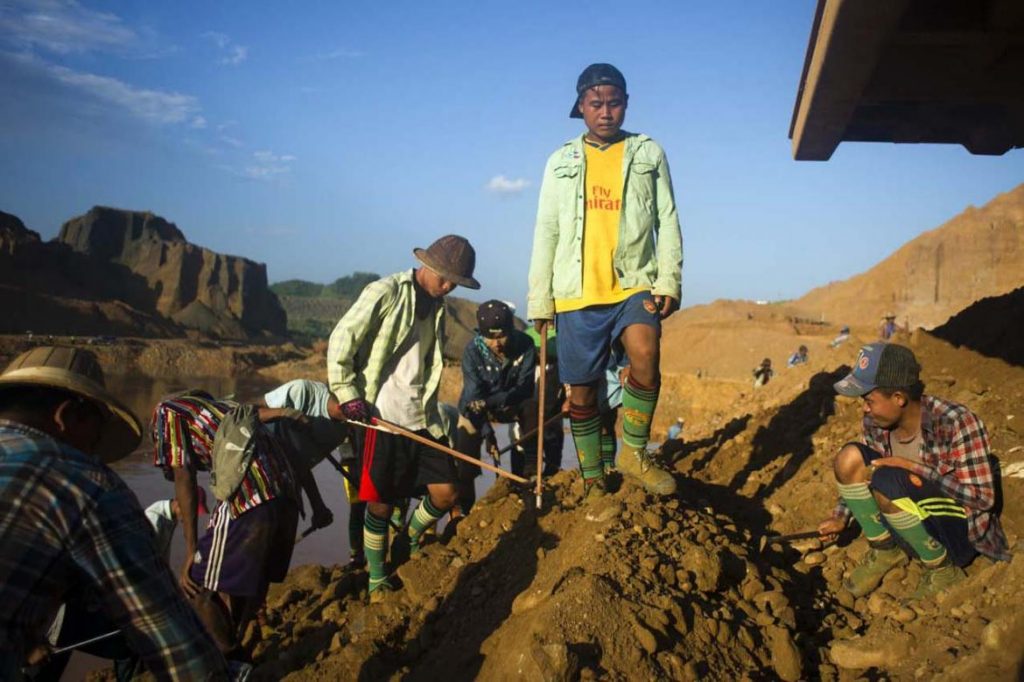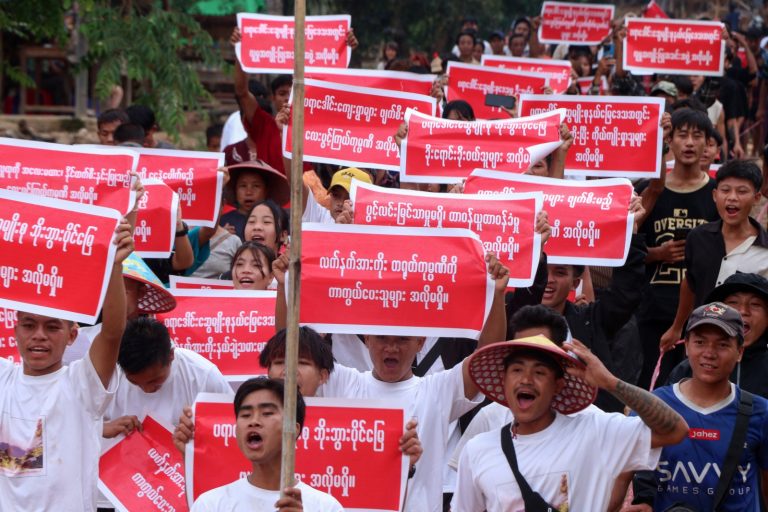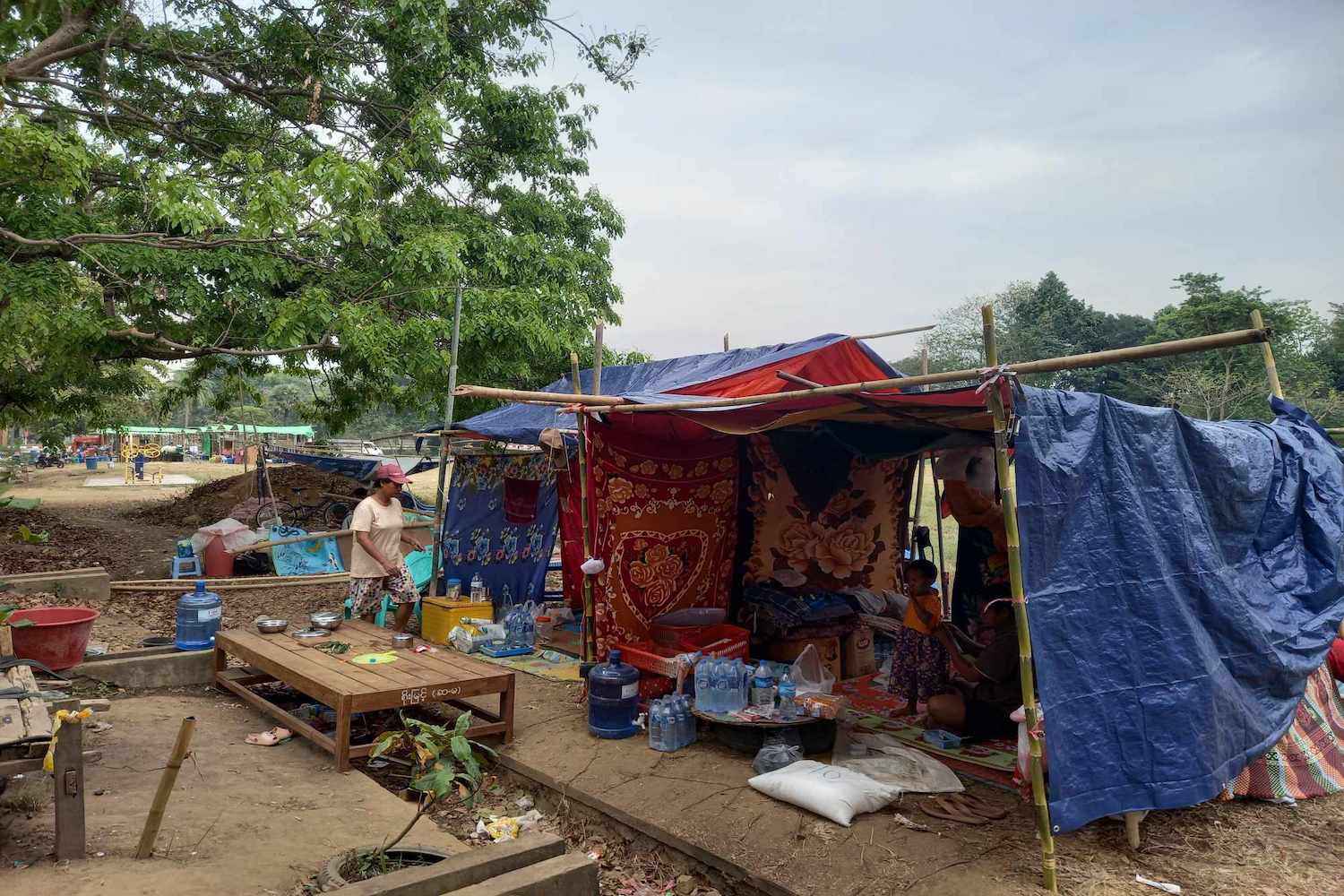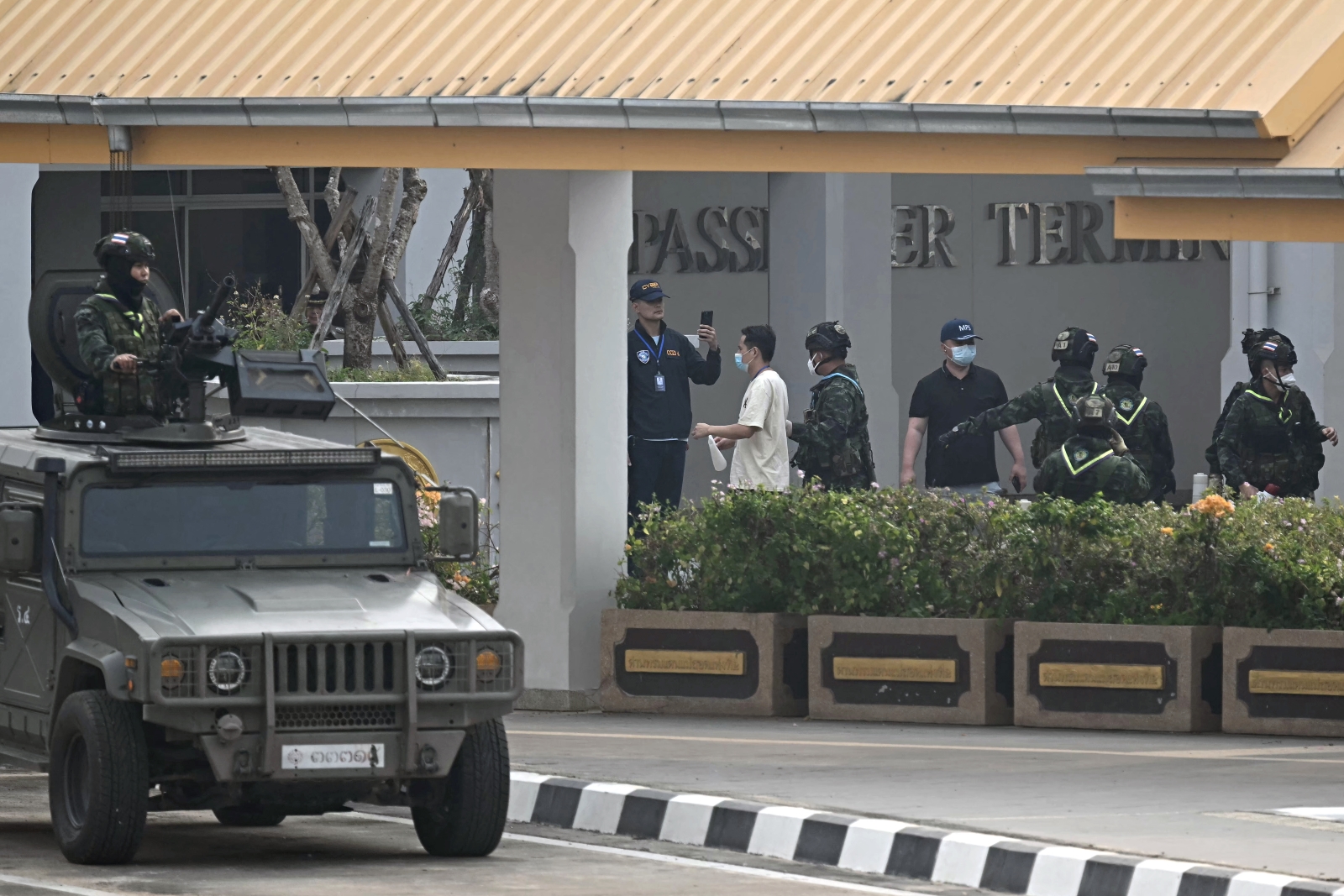The jade industry at Hpakant in Kachin State is a multi-billion-dollar business in which risk flows downhill, from the company bosses to the mid-level traders and, at the bottom, the itinerant miners known as yemase who risk their lives each day in the hope of striking it rich.
By DANIEL COMBS | FRONTIER
The Yemase
MOST DAYS, Hkun Myat wakes up at 4:30am so he can hit the hillside before sunrise. On his hands and knees, bundled in a cheap jacket to protect against the mountain air, he searches through the slag and rubble left over from the night before. Hkun Myat gets up early because he has more chance of snagging a valuable stone when there are fewer people on the slope. He is looking for jade, the semiprecious green stone that can mean the difference between going hungry and feeding his parents and siblings for the month.
In an average day, the 27-year-old miner will hit close to 1,000 individual stones with a small hammer, listening to the sound. “It took me a long time to understand what it really sounds like,” he says. “But once you know, you will never forget. Jade is a sweet sound.”
Hkun Myat has lived in Hpakant his entire life but he still sits on the bottom rung of Myanmar’s jade ladder. He is what is known as a yemase. It is an expression that means “to not wash with water”, and in this form refers to the customary rule that miners should not alter the appearance of jade stones before they sell them.
But it can also refer to the lifestyle surrounding the lowest levels of the jade trade. Of the hundreds of thousands of yemase working in Hpakant, very few find the miracle stone that will take them out of poverty. Most end up barely making ends meet. Instead, they often fall prey to manipulative businessmen, aggressive security forces, or the cheap and dangerously pure heroin that courses through Hpakant.
Support more independent journalism like this. Sign up to be a Frontier member.
In Myanmar’s jade industry, risk flows downhill – and the yemase are at the bottom. Their freelance mining is extremely dangerous. Frequent landslides in the mines can bury young men under tonnes of rubble. Yemase deaths are not uncommon, and families are rarely compensated for their losses.

Hkun Myat has lived in Hpakant his entire life but he still sits on the bottom rung of Myanmar’s jade ladder. (Daniel Combs | Frontier)
The work is also illegal: the yemase operate without licences, and without the consent of the mining companies from whose cast-offs they make a living. But because most stones the yemase recover eventually end up in the hands of larger trading companies, they are tacitly tolerated as a necessary, if expendable, part of the jade supply chain in Myanmar.
The population of yemase working in Hpakant has exploded in recent years, with hundreds of thousands thought to have moved into the area. The increased competition occasionally leads to confrontations with mining companies, especially when the yemase feel that their safety is not being taken into account. Before dump trucks deposit their slag on a hillside, the driver is supposed to honk the horn several times and flash their lights to warn the yemase on the slopes to watch out. But sometimes the drivers are in a hurry, or forget to honk, or else are just careless.
Yemase can be highly unified in their outrage to such negligence and they direct their frustration at the large mining companies. “The companies need to watch out for miners,” Hkun Myat says. “The companies make problems for us and put us in danger thoughtlessly. Then there is a problem. We will demonstrate and close the streets until we can negotiate with the company to change its behavior.”
In November 2016, Hkun Myat was working on a steep hill with 50 other yemase when the earth started moving. “People ran to get out of the way, but my friend got caught and was buried in stones up above his head,” he recalls. Instead of helping, other yemase ran to search through the dislodged stones. “I had to dig with one other person to pull him out.” No one else would help. His friend was lucky, but Hkun Myat knows of dozens of other yemase who have perished in sudden landslides.
When I ask Hkun Myat about his life plans, he says that he hopes to find a high-quality piece of jade and sell it. The right stone would make him a millionaire overnight. “Then I could get married and start a family, and get away from Hpakant.” When I ask him if he knows of any other yemase who have found a stone like that, he shakes his head. “No.”
Myanmar’s bounty
Gemologists differentiate between two types of jade. Nephrite is a soft, waxy stone, and generally appears in shades of pale green and ivory. The Chinese have mined nephrite since at least 5500BCE, and some of the earliest Chinese artifacts are nephrite carvings. For thousands of years, jade has played a central role in many Chinese religious and cultural practices. A Han dynasty poem illustrated the stone’s many values:
Benevolence lies in its gleaming surface,
Knowledge in its gleaming quality,
Uprightness in its unyieldingness,
Power in its harmlessness,
Eternity in its durability,
Moral leading in the fact that it goes from hand to hand without being sullied.
Jadeite is a harder, more vitreous stone, which sometimes presents as a brilliant, translucent shade of emerald green. The mountains of Kachin State hold the world’s only steady supply of high quality green jadeite, and almost all of it ends up in China. There, the stone often out-prices all other gems, save for coloured diamonds.

A pendant made from Myanmar jade on display at the Hong Kong Jewellery and Gem Fair in 2013. Although Myanmar law requires miners to sell their jade at emporiums in Nay Pyi Taw, most is instead smuggled to China. (AFP)
Myanmar has been exporting jade to China since at least the 13th century. The flow of jade has occasionally slowed as wars, political transitions and drastic economic upheavals have affected the trade. But the Chinese demand for jade has proven insatiable; after every hiccup, the industry has come roaring back to life.
In recent decades, as the Chinese economic miracle has propelled hundreds of millions of people into the middle class, jade has become an affordable luxury item and sales have skyrocketed. By 2014, one estimate valued Myanmar’s annual jade exports to China at over $30 billion.
The Gambler
Naw Ting is just starting out in the jade business. Once a month, the 30-year-old businessman makes the six-hour trip from his home in Myitkyina to Hpakant. A former employee in the Kachin State government, Naw Ting can afford to enjoy the cut-loose atmosphere of the mining town. “In Hpakant, you can do anything,” he tells me. “There are many restaurants, there is golf, there is karaoke, many massage places.”
Sometimes, he hires a group of yemase to work for him, and splits the profit for any valuable jade the group finds. Other times, he goes with other independent buyers to the top of a long ridge overlooking a steep slope covered in yemase diggers. There, the night is illuminated by the buyers’ high-powered flashlights, which they use to inspect the stones brought up by the yemase.
Jade stones are usually weathered and covered in a rough gray exterior, so it is never more than an educated guess about what the inside holds. If he likes what he sees, Naw Ting will buy a stone from a yemase, usually for about K10,000 or K20,000. “I am still learning how to identify the good jade,” he admits. “That is a skill that takes many years to develop.”
After buying a stone, he takes it to someone with a gemstone saw, who opens up the stone to reveal his fortune. Cutting open a stone is an enormous gamble. It could be the brilliant emerald green known as imperial jade, worth millions of dollars per kilogram, or it could be low grade utility stone not even worth the cost of transportation. You can never know for sure until the stone is split in two.
Naw Ting is a middleman, a position saturated with financial risk. Like the yemase, his work falls in a legal grey zone. Individuals that come to Hpakant to buy jade are not permitted to bring it out of the city without paying taxes as a registered company. So the only options for making a profit are to sell it to someone else in Hpakant for an artificially low price, or take the risk of transporting the stone illegally to China.
In April of this year, Naw Ting bought several jade stones. When one of these, for which he paid K130,000, was cut open, the core was bright green and translucent. He paid a group of smugglers to carry the stones across the mountains to China for K10,000 a kilogram.
A few weeks later, they called him to say the jade had arrived in the Chinese border town of Ruili, across from Muse in northern Shan State. Naw Ting’s stone was likely taken through territory controlled by ethnic armed groups, but the smugglers refuse to reveal their routes to businessmen they contract with. “They never tell you how they carry the stone,” Naw Ting said. “It is for their protection as well.”
The escalation in fighting between the Kachin Independence Army (KIA) and the Tatmadaw earlier this year has injected further risk into the transportation process. With more frequent military patrols, smugglers are often apprehended and stripped of their jade before being released. Smugglers who are arrested have a hard time rebuilding their reputation following such a loss, as businessmen – who are not compensated for their losses – avoid groups that cannot effectively deliver to the Chinese side of the border.

Nawng Ting tees off at a golf course in Myitkyina. (Daniel Combs | Frontier)
In Ruili, Naw Ting worked with resident Myanmar jade merchants to sell his jade to Chinese buyers. The high-quality stone fetched close to US$1,000. Even after the 5 percent commission charged by the salesman, Naw Ting was able to return to Myitkyina with a large profit. He plans to reinvest it into more jade.
“I’m already planning another trip to Hpakant tomorrow,” he said upon his return. “It’s important for me to get more skill and experience to predict which jade will be good quality. Not everyone in Ruili is lucky enough to make a profit.”
Missing billions
The jade trade lends itself to tax evasion and money laundering; its very nature makes it difficult to regulate. More than any other precious stone, the consumer – not the market – sets the value for jade. That means there is no standard that regulators can use to judge the value of a stone, and therefore how much tax should be levied.
“Value is in the eye of the beholder,” one Chinese jade merchant living in northern Myanmar told me. “I can sell a stone for $2,000, but I only write $20 on the receipt. Or maybe I don’t write a receipt at all. There’s no way for the government to check or oversee.”
The ease with which merchants can evade oversight means that the government only raises around $500 million a year from jade sales – a small slice of the pie when annual revenues reach far into the billions of dollars. Data from Myanmar’s Extractive Industries Transparency Initiative (EITI) reports show that most of that money comes from the Myanmar Gems Enterprise, through its regular gem emporiums in Nay Pyi Taw. But part of it is also raised through tax collectors in Hpakant, who levy duties on extraction and transportation.
Non-state groups also collect their share of this lucrative trade. By limiting their taxation to the highest value stones, the Kachin Independence Organization – the political wing of the KIA – is able to raise money quickly and effectively. One study, by the Ash Center for Democratic Governance and Innovation at Harvard University, estimates that the KIO employs 10 tax collectors in Hpakant, who raise $1 billion every year by extorting companies and traders. These payments are illegal under Myanmar law, so, according to a KIO spokesman, they are listed in the companies’ accounting records as “donations to local charities”
The Boss
U Bum Yun started working in Hpakant in the early 1970s, travelling to the mining town from Myitkyina during his school vacations. “Jade was already very famous in Kachin when I started,” he remembers. “People were rich because of jade. They could afford an education because of jade.”
Bum Yun has worked his way up the jade ladder to become one of the most successful Kachin mine owners. But when he looks at the industry, all he sees are problems. His company, Jinghpaw Academy, owns mining concessions across Hpakant totalling more than 100 acres, but at many of the sites he has to work in partnership with the Myanmar Gems Enterprise or Tatmadaw companies, whose aggressive mining practices he dislikes.
Since taking office in March 2016, the National League for Democracy government has sought to reform the jade industry by updating the country’s mining regulations and introducing a moratorium on renewals of mining licences. Bum Yun and other ethnic Kachin jade bosses claim that companies with links to the military have been able to consolidate ownership claims and continue operating without government oversight. Large Tatmadaw-linked companies have often surrounded groups of smaller, Kachin-held mines. Once the larger companies excavate, it becomes physically impossible for the small-scale mine owners to gain access to the site, and they are forced to sell their concessions to the larger companies.
Bum Yun supports the reform process and thinks it offers is a chance to level the playing field in the jade industry. “There is no rule of law in Hpakant right now,” he says. “That’s why thousands of yemase can just go to the company’s mine areas with no permission. The company pays tax to the government, but the government says it’s not their problem. They just tell us, ‘Go to the police or the Tatmadaw with your problems.’ So then we have to take the issue into our own hands, and there is no consistency. The government needs to take a supervisory role and actually solve our problems.”

Jade has made Bum Yun a rich man. (Daniel Combs | Frontier)
Still, jade has made Bum Yun a rich man. His house in Myitkyina is an enormous three-storey building enclosed by a high fence. Circular columns covered in mosaics of jade hold up the second floor balcony. Inside, the hallways are scattered with jade boulders that rest on ornate pedestals; in his spacious sitting room someone has hung up a large framed landscape of the Kachin mountains. The whole picture is green, white, and brown – a meticulous construction of tiny jade rocks.
A photo album on the table recounts a career of success. In one picture, Bum Yun and a colleague crouch in an underground tunnel. Behind them, a bright green vein of jadeite shines out from rock wall. “For me, there is no gambling,” he says. “I only dig when I am very sure. With jade like this, you can be quite sure of success.”
According to Myanmar law, Bum Yun and other jade merchants must sell all of their jade at the annual emporium in Nay Pyi Taw. But with stones of high quality, Bum Yun says, there is very little incentive to follow the rules. Cumbersome tax regulations, which most merchants say do not align with the jade industry’s business model, encourage underground trade. And it is easy to skirt the government’s tax collector by smuggling the rocks out of the country. “We send it to China, because Myanmar’s policies don’t fit in with the business,” Bum Yun says matter-of-factly. “Besides, people never send quality stones to the emporium. Everyone sends it illegally to other countries.”
But Bum Yun does still spend time in the capital. In his house, he has a picture of a 41.5-tonne jade boulder in front of a government building in Nay Pyi Taw. “That is my jade,” he says. “I didn’t sell, just gave it to the government.” He shrugs. “That’s the price of doing business.”
Sitting at the top of the jade ladder, risk virtually disappears. With the benefit of security, Bum Yun can look down at the industry and think about the hundreds of thousands of lives it has affected.
“There is a perspective that jade is the only thing that can make people rich in a short time,” he notes. “But because of jade, Kachin has suffered a lot. There is so much mismanagement.”







